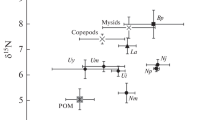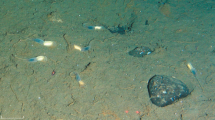Abstract
Between 1981–83 the gut contents ofDaphnia galeata, D. cucullata, Eudiaptomus gracilis, andCyclops vicinus were examined with light and scanning electron microscope to obtain information on the feeding of these species in Lake Balaton. The twoDaphnia species feed mainly on abioseston, and it is assumed that their primary nutrient source was organic matter adsorbed onto the surfaces of the abioseston granules plus bacteria and detritus.E. gracilis feeds on algae, showing a preference for green algae and diatoms.C. vicinus is also a prodigious consumer of algae in Lake Balaton, utilizing the whole size spectrum of phytoplankton.
Concerning the trophic relationships between phytoplankton and zooplankton in Lake Balaton, that between diatoms and bothE. gracilis andC. vicinus is the most conspicouos. Convincing evidence for an extensive utilization of blue-green algae was not found. Though there is no firm evidence yet, it is likely that theDaphnia are dependent on organic matter adsorbed on the abioseston.
Similar content being viewed by others
References
Alcaraz, M., G.-A. Paffenhöfer & J. R. Strickler, 1980. Catching the algae: A first account of visual observations on filter-feeding calanoids. In W. C. Kerfoot (ed.), Evolution and Ecology of Zooplankton Communities. The University Press of New England, Hanover (N.H.); Lond.: 241–248.
Arruda, J. A., G. R. Marzolf & R. T. Faulk, 1983. The role of suspended sediments in the nutrition of zooplankton in turbid reservoirs. Ecology 64: 1225–1235.
Brandl, Z. & C. H. Fernando, 1978. Prey selection by the cyclopoid copepodsMesocylops edax andCyclops vicinus. Verh. int. Ver. Limnol. 20: 2505–2510.
Burns, C. V., 1968. The relationship between the body size of filter-feeding Cladocera and the maximum size of particle ingestion. Limnol. Oceanogr. 13: 675–678.
De Bernardi, R., G. Giussani & E. L. Pedretti, 1981. The significance of blue-green algae as food for filter-feeding zooplankton: experimental studies onDaphnia spp. fed byMicrocystis aeruginosa. Verh. int. Ver. Limnol., 21: 477–483.
Entz, B., 1981. Windgeschwindigkeit, Schwebstoffmengen und Lichtverhältnisse im Balatonsee. BFB-Bericht 42: 69–78.
Ferguson, A. J. D., J. M. Thompson & C. S. Reynolds, 1982. Structure and dynamics of zooplankton communities maintained in closed systems, with special reference to the algal food supply. J. Plankton Res. 4: 523–543.
Fryer, G., 1957. The feeding mechanism of some freshwater cyclopoid copepods. Proc. zool. Soc. Lond. 129: 1–25.
Geller, W. & Müller, 1981. The filtration apparatus of Cladocera: filtering mesh-sizes and their implications on food selectivity. Oecologia (Berl.) 49: 316–321.
Gliwicz, Z. M., 1969. Studies on the feeding of pelagic zooplankton in lakes with varying trophy. Ekol. Pol. Ser. A, 17: 666–708.
Gliwicz, Z. M. & E. Siedlar, 1980. Food size limitation and algae interfering with fod collection inDaphnia. Arch. Hydrobiol. 88: 155–177.
G.-Tóth, L., 1980. The use of dialyzing sacks in estimation of production of bacterioplankton and phytoplankton. Arch. Hydrobiol. 89: 474–482.
G.-Tóth, L., 1982. Über die Zusammensetzung der im Wasser des Balatonsees suspendierten Stoffe und einige Beobachtungen über deren Einfluss auf die Nahrungsaufnahme einiger Zooplankter. BFB-Bericht 43: 145–156.
G.-Tóth, L., 1984. Feeding behaviour ofDaphnia cucullata Sars in the easily stirred up Lake Balaton as established on the basis of gut content analyses. Arch. Hydrobiol. 101: 533–553.
G-Tóth, L. & J. Padisák, 1978. Short-term investigations on the phytoplankton of Lake Balaton at Tihany. Acta Bot. Hung. 24: 197–204.
G-Tóth, L. & N. P. Zánkai, 1985. Feeding ofCyclops vicinus (Ulianine) (Copepoda: Cyclopoida) in Lake Balaton on the basis of gut content analyses. Hydrobiologia 122: 251–260.
G.-Tóth, L., K. V. Balogh & N. P. Zánkai, 1986. Significance and degree of abioseston consumption in the filter-feederDaphnia galeata Sars em. Richard (Cladocera) in Lake Balaton. Arch. Hydrobiol. 106: 45–60.
Hintz, H. W., 1951. The role of certain arthropods in reducing mosquito populations of permanent ponds in Ohio, Ohio J. Sci. 51: 277–279.
Holm, N. P., G. G. Ganf & J. Shapiro, 1983. Feeding and assimilation rates ofDaphnia pulex fedAphanizomenon flosaquae. Limnol. Oceanogr. 28: 677–687.
Infante, A., 1973. Untersuchungen über die Ausnutzbarkeit verschiedener Algen durch das Zooplankton. Arch. Hydrobiol. Suppl. 42: 340–405.
Lampert, W., 1977. Studies on the carbon balance ofDaphnia pulex as related to environmental conditions. I. Methodological problems of the use of14C for the measurement of carbon assimilation. Arch. Hydrobiol. Suppl. 48: 287–309.
Meskova, T. M., 1975. Zachonomernosty rozwityja zooplanktona v ozere Sevan (Regularity of zooplankton living in Lake Sevan)., Izd. AN ASSR Erevan: 1–237. (in Russian).
Monakov, A. V. & T. I. Pugatcheva, 1971. Predvaritel'nye dannye o pitaniiCyclops vicinus (Copepoda, Cyclopoida). (Preliminary data on the nutrition of C.v.) Inform. byull. Inst. biol. vnutr. vod. 10: 40–42. (in Russian).
Németh, J. & L. Vörös, 1984. Módszertan és koncepció a felszini vizek algológiai monitoringjához. (Methodology and conception for the algological monitoring system of surface waters). Környezetvédelmi Intézet Kiadványa, Budapest, 1–264. (in Hungarian).
Padisák, J., L. G.-Tóth & L. Vörös, 1984.Anabaenopsis raciborskii Wolosz. bloom in Lake Balaton in the summer and autumn of 1982. BFB-Bericht 51: 77–81.
Ponyi, J. & N. P. Zánkai, 1979. Population dynamics, biomass and biomass-production ofEudiaptomus gracilis (G. O. Sars) in two different trophic areas of the Lake Balaton. Acta biol. Debrecina 16: 17–36.
Porter, K. G., 1973. Selective grazing and differential digestion of algae by zooplankton. Nature 224: 179–180.
Porter, G. P., 1977. The plant-animal interface in freshwater ecosystems. Am. Scient., 65: 159–170.
Price, H. J., G.-A. Paffenhöffer & J. K. Strickler, 1983. Models of cell capture in calanoid copepods. Limnol. Oceanogr. 28: 116–123.
Richman, S. & S. I. Dodson, 1983. The effect of food quality on feeding and respiration byDaphnia andDiaptomus. Limnol. Oceanogr., 28: 948–956.
Richman, S., S. A. Bohon & S. E. Robins, 1980. Grazing interactions among freshwater calanoid copepods. In W. C. Kerfoot (ed.), Evolution and Ecology of Zooplankton Communities. The University Press of New England, Hanover (N.H.); Lond.: 219–233.
Sebestyén, O., 1958. Quantitative plankton studies on Lake Balaton. IX. A summary of the biomass studies. Annal. Biol. Tihany 25: 218–292.
Tamás, G., 1955. Quantitative studies on phytoplankton of Lake Balaton IV. Biomass of the phytoplankton in the forties. Anal. Biol. Tihany 23: 95–109.
Vetter, H., 1937. Limnologische Untersuchungen über das Phytoplankton und seine Beziehungen zur Ernahrung des Zooplanktons im Schleinsee bei Langenargen am Bodensee. Int. Revue ges. Hydrobiol. Hydrogr. 34: 449–561.
Zánkai, N. P., 1983. Ingestion rates of someDaphnia species in a shallow lake (Lake Balaton, Hungary). Int. Revue ges. Hydrobiol. 68: 227–237.
Zánkai, N. P., 1984. Predation ofCyclops vicinus (Copepoda: Cyclopoida) on small zooplankton animals in Lake Balaton (Hungary). Arch. Hydrobiol. 99: 360–378.
Zánkai, N. P., 1985. Kékalga vizvirágzás hatása a rákplankton összetételére a Balatonban (The effect of blue-green algal blooming on the composition of crustacean plankton in Lake Balaton). Hidrológiai Közlöny 2: 78–84 (in Hungarian).
Zánkai, N. P. & J. E. Ponyi, 1976. Seasonal changes in the filtering rate ofEudiaptomus gracilis (G. O. Sars) in Lake Balaton. Annal. Biol. Tihany 43: 105–116.
Zánkai, N. P. & J. E. Ponyi, 1986. Composition, density and feeding of crustacean zooplankton community in a shallow, temperate lake (Lake Balaton, Hungary). Hydrobiologia 135: 131–147.
Author information
Authors and Affiliations
Rights and permissions
About this article
Cite this article
G.-Tóth, L., Zánkai, N.P. & Messner, O.M. Alga consumption of four dominant planktonic crustaceans in Lake Balaton (Hungary). Hydrobiologia 145, 323–332 (1987). https://doi.org/10.1007/BF02530294
Issue Date:
DOI: https://doi.org/10.1007/BF02530294




